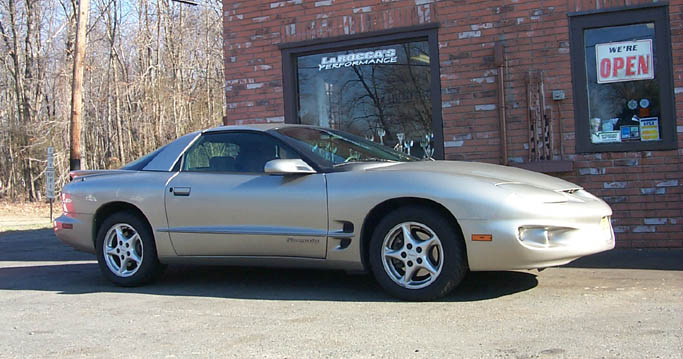
FAST-ACTING FORMULA
by Scott Mandel
Photography by the author


|
It's
common knowledge that the LS1 motors are probably the most powerful,
naturally aspirated, small-block V-8's ever mass-produced. That
fact was more than enough to lure me from the Ford camp to the Dark
Side. I purchased the 1999 Pontiac Firebird Formula that you see
on these pages. It has a hardtop (no t tops) and a 6 speed manual
transmission; no other options were selected. With
4800 miles on the odometer, I felt it was time to see if the
claims of 12 second timeslips were true. I swapped the rear Goodyear
GS-C's for BFG Drag Radials and headed for E-town. My sixth pass was
my best: 12.93 at 107.7 mph!!! |
I learned a few lessons about my
car that night. The stock
clutch does not liked to be slipped; it's just not strong enough to
handle the traction afforded by the drag radials when driven that way.
Best 60 foot times were accomplished with a launch RPM of between 3000-3500
and popping the clutch. I also found that the tachometer is very
slow to catch up to the actual RPM's, especially in the first two gears.
The fuel cut-off would interrupt the fun at an indicated 5800-RPM in
first gear. Therefore, it is imperative to anticipate the first-to-second
shift; or one can simply install a shift-light. |
Shortly thereafter, LaRocca's Performance strapped the Formula to their Dyno-Jet Chassis Dyno. The car made
290 hp and 310.6 ft/lbs of torque. That is exactly what we expected the car to make.
The Direct-Flo Lid is a relatively new product, and it is manufactured by LS1 Motorsports. It replaces the factory airbox lid in an effort to reduce the turbulence found before the air enters the motor. It's hard to believe that this plastic piece (which costs approx $150) increased rear-wheel power by 7.4 hp and 4.4 ft/lbs of torque. The car was now making 297.4 hp and 315 ft/lbs of torque. |
|
Our
next product to evaluate was a Random Technology Cat-back exhaust system.
This product consists of 3-inch tailpipes, a straight-thru muffler,
and 3 inch tubing from the cat to the muffler. Super-tech Jimmy
Chahalis installed this system within two hours, and the muffler clamps
were welded to ensure a tight, leak-free fit. We've read claims of 20
rear-wheel hp gains from this mod alone, and we were anxious to verify
them. |
We took an intentional step backwards by removing the Direct-Flo lid and replaced that with the factory lid. This would show us how much hp the cat-back system would give a completely stock car. 299 hp and 315 ft/lbs were the resultants. Based on our stock numbers, the exhaust netted 9 hp and 5 ft/lbs. Our final test would prove just how restrictive the stock location of the EGR is. The EGR in an F-body sticks out more than one inch in the center of the throttle body and directly in the path of |
incoming air.
We decreased the length of the EGR so that it no longer impedes airflow into the motor. This easy mod took less than five minutes to accomplish. We noticed a gain of 3 hp and 1.5 ft/lbs, which brought the total horsepower to 307 and torque was now at 321.
|
|
This timeslip is what it is all about. Any car that can run a 12 second 1/4 mile is worthy of respect. We shall retest this car as soon as E-town re-opens for the 2000 racing season. With some good conditions, we're hoping for some 12.7's (Nevermind that "Riceboy" comment). |
This dyno graph shows how much power was gained by a few simple mods. I think more power would have been possible if the motor were warmed to operating temperature and if the computer was given time to relearn the characteristics of the new parts.
|